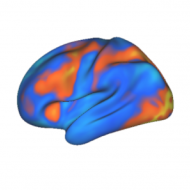 24) Cognitive control processes are distributed within a network of distinct regions (Goldman-Rakic – 1988, Posner – 1990, Wager & Smith 2004, Cole & Schneider – 2007)
24) Cognitive control processes are distributed within a network of distinct regions (Goldman-Rakic – 1988, Posner – 1990, Wager & Smith 2004, Cole & Schneider – 2007)
Researchers investigating eye movements and attention recorded from different parts of the primate brain and found several regions showing very similar neural activity. Goldman-Rakic proposed the existence of a specialized network for the control of attention.
This cortical system consists of the lateral frontal cortex (fronto-polar, dorsolateral, frontal eye fields), medial frontal cortex (anterior cingulate, pre-SMA, supplementary eye fields), and posterior parietal cortex. Subcortically, dorsomedial thalamus and superior colliculus are involved, among others.
Many computational modelers emphasize the emergence of attention from the local organization of sensory cortex (e.g., local competition). However, when a shift in attention is task-driven (i.e., top-down) then it appears that a specialized system for attentional control drives activity in sensory cortex. Many properties of attention likely arise from the organization of sensory cortex, but empirical data indicate that this is not sufficient.
With the advent of neuroimaging in humans (PET and fMRI), Posner et al. found very similar regions as those reported by Goldman-Rakic. He found that some regions are related more to orienting to stimuli, while others are related more to cognitive control (i.e., controlled processing).
After many fMRI studies of cognitive control were published, Wager et al. performed a meta-analysis looking at most of this research. They found a set of cortical regions active in nearly all cognitive control tasks.
My own work with Schneider (in press) indicates that these regions form an innate network, which is better connected than the rest of cortex on average. We used resting state correlations of fMRI BOLD activity to determine this. This cognitive control network is involved in controlled processing in that it has greater activity early in practice relative to late in practice, and has greater activity for conflicting responses (e.g., the Stroop task).
Though these regions have similar responses, they are not redundant. Our study showed that lateral prefrontal cortex is involved in maintaining relevant task information, while medial prefrontal cortex is involved in preparing and making response decisions. In most cases these two cognitive demands are invoked at the same time; only by separating them in time were we able to show specialization within the cognitive control network. We expect that other regional specializations will be found with more work.
I’ll be covering my latest study in more detail once it is published (it has been accepted for publication at NeuroImage and should be published soon). The above figure is from that publication. It lists the six regions within the human cognitive control network. These regions include dorsolateral prefrontal cortex (DLPFC), inferior frontal junction (IFJ), dorsal pre-motor cortex (dPMC), anterior cingulate / pre-supplementary motor area (ACC/pSMA), anterior insula cortex (AIC), and posterior parietal cortex (PPC).
A general computational insight arising from this work (starting with Goldman-Rakic) is that cortex is composed of specialized regions that form specialized networks. This new paradigm for viewing brain function weds the old warring concepts of localized specialization and distributed function.
Implication: The mind, largely governed by reward-seeking behavior on a continuum between controlled and automatic processing, is implemented in an electro-chemical organ with distributed and modular function consisting of excitatory and inhibitory neurons communicating via ion-induced action potentials over convergent and divergent synaptic connections altered by timing-dependent correlated activity often driven by expectation errors. The cortex, a part of that organ organized via local competition and composed of functional column units whose spatial dedication determines representational resolution, is composed of many specialized regions forming specialized networks involved in perception (e.g., touch: parietal, vision: occipital), action (e.g., frontal), and memory (e.g., short-term: prefrontal, long-term: temporal), which depend on inter-regional connectivity for functional integration, population vector summation for representational specificity, and recurrent connectivity for sequential learning.
[This post is part of a series chronicling history’s top brain computation insights (see the first of the series for a detailed description). See the history category archive to see all of the entries thus far.]
-MC
